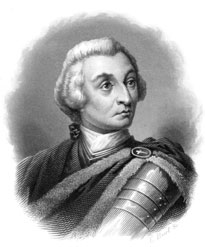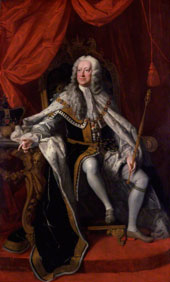Small Planet Communications, Inc. + 15 Union Street, Lawrence, MA 01840 + (978) 794-2201 + Contact







The last of the 13 colonies to be founded, Georgia began as a line of fortress towns, creating a buffer between English settlers in the Carolinas and the Spanish in Florida. Created as a land for English debtors to start fresh in the New World, Georgia was a land filled with promise. Once the colonists realized the potential of the land, however, they recognized Georgia not just as a place to start a new life, but as a place to achieve financial success.
Dr. Henry Woodward was the first Englishman to explore the area of present-day Georgia around 1670. It was not until 1724, however, that Jean Pierre Purry suggested the land be settled as an English colony. Named Georgia, in honor of King George II who granted the charter eight years later, it was the last of the 13 original colonies. The Crown's interest in the colony was to increase trade and wealth for England, expand and strengthen their existing colonies, and act as a military buffer zone protecting valuable South Carolina against the Spanish colonists in Florida.

Read a biography of Georgia's
founder, James Edward Oglethorpe.
General James Edward Oglethorpe conceived of the idea to move imprisoned English debtors to settle Georgia. Oglethorpe was a philanthropist who was troubled by the misery of the poor in England. He was also an experienced soldier who was greatly admired by his peers. When Oglethorpe and a group of 20 others approached King George II with the plan in 1732, the Royal Charter for the colony of Georgia was granted.
With the 21 men acting as trustees, they were granted the status of a corporation with power to elect their own council, grant lands, enact laws, and raise taxes. To avoid a conflict of interest with their charitable aims, however, no trustee was allowed to make money on the enterprise. In addition, the trustees agreed to turn over their power to the Crown after 20 years.
Oglethorpe and Tomochichi
became lifelong friends.
Read more about the life
of Tomochichi and how he
helped English colonialism.
Oglethorpe and the first group of 114 settlers embarked from England on board the Anne, landing at Yamacraw Bluff on the Savannah River early in 1733. Oglethorpe had secured this advantageous location as the site of the first settlement by negotiating with the local Yamacraw sachem (chief), Tomochichi. The new settlement, Savannah, was easily defensible atop the bluff. Savannah was laid out as a series of squares, which were in turn divided into house lots, with gardens and farms to the rear.
Since the plan was to benefit the poor, the trustees limited the size of landholdings. No grant of land was to exceed 500 acres. In addition, the settlers could neither sell nor transfer their holdings, nor divide them into portions of less than 50 acres. Prospective settlers were to receive free passage and be given cattle, land, and subsistence until they established themselves. The new colony was to be laid out in compact townships to which everyone would be confined, thus facilitating defense and the formation of a militia.
The first year was difficult for the colonists. Clean water was scarce, and illness spread through the population. Also, many of the settlers had lived in cities in England, and they did not know how to survive by farming. Fortunately, the colonists received help from the local Yamacraw Indians, thanks to the friendship that had developed between Oglethorpe and Tomochichi. Georgia also received aid from the neighboring South Carolinians.
Other groups of settlers arrived from Europe, including persecuted Puritans, Lutherans, and Quakers. Discontent between the trustees and colonists soon began. The trustees expected gratitude from the recipients for their charity. Instead the settlers voiced their frustrations, particularly over the restrictions on where they could settle and what they could do with their land. Many were discouraged by the decision in January 1735 to prohibit slavery. Another subject of discord was the trustees' attempt to prevent the importation of rum and other spirits.
DID YOU KNOW?
Georgia has had five different
capital cities—Savannah,
Augusta, Louisville, Milledgeville,
and Atlanta. Click to learn more
fun facts about Georgia.
Explore more history of Georgia.
For a time, criticism was diverted by four years of war against Spain, beginning with the War of Jenkins' Ear in 1739. But after the fighting died down in the early 1740s, the trustees slowly had to give way on various aspects of their model society. These concessions, including the reinstatement of slavery in 1751, represented almost the last act of the trustees. Oglethorpe returned to England, never to return to the colony that he founded, and the trustees turned control of the colony back over to the king, even with time remaining on their charter.
Georgia became another royal colony—complete with a governor, council, and provincial assembly—and patterned itself after South Carolina. Rice plantations, owned by a wealthy elite and worked by enslaved Africans dominated the tidewater, while small struggling farms were common elsewhere.
Georgia | Bibliography
- Digital Library of Georgia. "The Story of Georgia's Capitols and Capital Cities." Accessed 6/20/19. http://georgiainfo.galileo.usg.edu/capital.htm
- Digital Library of Georgia. "This Day in Georgia History." Accessed 6/20/19. http://georgiainfo.galileo.usg.edu/tdgh-jan/jan01.htm
- History of the USA. Converted from Henry William Elson's History of the United States of America. The MacMillan Company, NY, 1904. "Georgia." Accessed 6/20/19. http://www.usahistory.info/southern/Georgia.html
- Library of Congress. "The Georgia Trustees Justify Their Policies, 1742." Accessed 6/20/19. http://www.loc.gov/teachers/classroommaterials/
presentationsandactivities/presentations/timeline/colonial/georgia/trustees.html - The New Georgia Encyclopedia. "Georgia History: Overview." Accessed 6/20/19. http://www.georgiaencyclopedia.org/articles/history-archaeology/georgia-history-overview
- The New Georgia Encyclopedia. "Tomochichi." Accessed 6/20/19. http://www.georgiaencyclopedia.org/articles/history-archaeology/tomochichi-ca-1644-1739
- Taylor, Samuel. "Colonial Georgia." Our Georgia History. Accessed 6/20/19. http://www.ourgeorgiahistory.com/history101/gahistory03.html
- Taylor, Samuel. "James Edward Oglethorpe." Our Georgia History. Accessed 6/20/19. http://www.ourgeorgiahistory.com/people/oglethorpe.html
- Taylor, Samuel. "The Age of Exploration in Georgia." Our Georgia History. Accessed 6/20/19. http://www.ourgeorgiahistory.com/history101/gahistory02.html
Georgia | Image Credits
- King George II | Artist: Thomas Hudson, 1744; National Portrait Gallery, London
- James Oglethorpe | Artist: Charles K. Burt, c. 1879; U.S. History Images
© 2020 Small Planet Communications, Inc. + Terms/Conditions + 15 Union Street, Lawrence, MA 01840 + (978) 794-2201 + planet@smplanet.com



